Related Research Articles

Clan Gunn is a Highland Scottish clan associated with lands in northeastern Scotland, including Caithness, Sutherland and, arguably, the Orkney Isles. Clan Gunn is one of the oldest Scottish Clans, being descended from the Norse Jarls of Orkney and the Pictish Mormaers of Caithness.

St Magnus Cathedral, Kirkwall dominates the skyline of Kirkwall, the main town of Orkney, a group of islands off the north coast of mainland Scotland. It is the most northerly cathedral in the United Kingdom, a fine example of Romanesque architecture built for the bishops of Orkney when the islands were ruled by the Norse Earls of Orkney. It is owned not by the church, but by the burgh of Kirkwall as a result of an act of King James III of Scotland following Orkney's annexation by the Scottish Crown in 1468. It has its own dungeon.
This is a list of the High Sheriffs of the English county of Northumberland. The High Sheriff is the oldest secular office under the Crown. Formerly the High Sheriff was the principal law enforcement officer in the county but over the centuries most of the responsibilities associated with the post have been transferred elsewhere or are now defunct, so that its functions are now largely ceremonial. The High Sheriff changes every March.
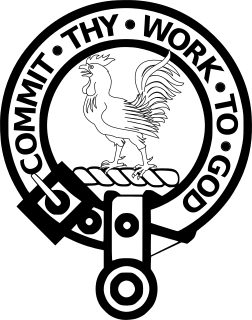
Clan Sinclair is a Highland Scottish clan who held lands in Caithness, the Orkney Islands, and the Lothians. The chiefs of the clan were the Barons of Roslin and later the Earls of Orkney and Earls of Caithness. The Sinclairs are believed to have come from Normandy to England during the Norman conquest of England, before arriving in Scotland in the 11th century. The Sinclairs supported the Scottish Crown during the Scottish–Norwegian War and the Wars of Scottish Independence. The chiefs were originally Barons of Roslin, Midlothian and William Sinclair, 1st Earl of Caithness and Baron of Roslin founded the famous Rosslyn Chapel in the 15th century. He split the family lands, disinheriting his eldest son from his first marriage, William, who later became the second Lord Sinclair, instead giving the lands of Caithness to the second son from his second marriage, William Sinclair, 2nd Earl of Caithness, in 1476, and the lands at Roslin to his eldest son from his second marriage, Sir Oliver Sinclair. In the 16th century the Sinclairs fought against England during the Anglo-Scottish Wars and also feuded with their neighbors the Clan Sutherland. During the Jacobite rising of 1715 the Sinclairs supported the Jacobite cause, but during the Jacobite rising of 1745, while the clan largely had Jacobite sympathies, their chief, the Earl of Caithness, supported the British-Hanoverian Government. The current chief is Malcolm Sinclair, 20th Earl of Caithness.

The House of Burnett is a Lowland and Border Scottish family composed of several branches. The Chief of the Name and Arms of Burnett is James Comyn Amherst Burnett of Leys, Baron of Kilduthie. They are from Deeside, near Banchory, in Northeast Scotland. From the early 14th century to the mid 16th century the family occupied a lake dwelling on the Loch of Leys, and resided there or on land near the lake for over 200 years. It is from this lake that the family eventually acquired the designation "of Leys".
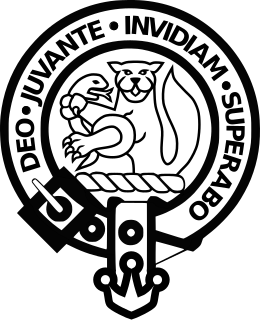
Clan MacThomas is a Highland Scottish clan and is a member of the Clan Chattan.
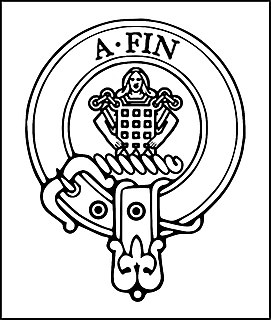
Clan Ogilvy/Ogilvie is a Scottish clan. The Ogilvy family originate in Angus, Scotland. Gillebride, Earl of Angus, received a Barony from King William the Lion in 1163 and bestowed the lands of Ogilvy upon his son Gilbert. Of this extraction, Patrick de Ogilvy later swore fealty to the Hammer of the Scots and appears on the Ragman Rolls of 1296. His son Sir Patrick Ogilvie in turn received a charter from Robert the Bruce for the lands of Kettins. In 1491, King James IV elevated Sir James Ogilvy to the ranks of the peerage as Lord Ogilvy of Airlie.

Clan Leask is a Scottish clan.
Clan Strachan is a Scottish clan originating from the barony of Strachan, in Aberdeenshire. The clan does not have a chief, therefore it is considered by Court of the Lord Lyon and the Stand Council of Scottish Chiefs as an Armigerous clan.
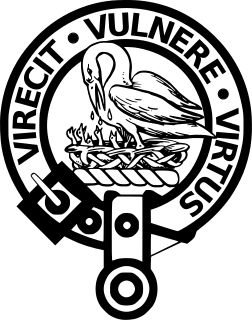
Clan Stewart is a Highland Scottish clan. The clan is recognised by Court of the Lord Lyon; however, it does not have a Clan Chief recognised by the Lord Lyon King of Arms. Because the clan has no chief it can be considered an armigerous clan; however, the Earls of Galloway are now considered to be the principal branch of this clan, and the crest and motto of The Earls of Galloway's arms are used in the Clan Stewart crest badge. The Court of the Lord Lyon recognises two other Stewart/Stuart clans, Clan Stuart of Bute and Clan Stewart of Appin. Clan Stuart of Bute is the only one of the three clans at present which has a recognised chief.

Clan Spens or Spence is a Lowland Scottish clan and is also a sept of Clan MacDuff.
The Selby family is a prominent and prolific family in the English gentry that originated in Selby, Yorkshire, but largely settled in Northumberland and County Durham. At various points through history, the family owned Biddlestone Hall and Twizell Castle in Northumberland in addition to the manor houses Ightham Mote in Kent and at Beal, Northumberland. The family had two baronetcies; the Selby and the Selby-Bigge but both are now extinct.

James Law was Archbishop of Glasgow. Entering the church after graduation from university, he rose to the position of Bishop of Orkney, reorganising the diocese, before rising to hold the position of Archbishop of Glasgow.
The Ogle family were prominent landed gentry in Northumberland. The earliest appearances of the family name were written Hoggel, Oggehill, Ogille and Oghill.
The Shafto family is an alternative surname for the Ffolliot family, who were established in the 14th century at Shafto Crag, Northumberland and adopted the alternative surname of Shafto.
Sir John Delaval was an English landowner and politician who sat in the House of Commons in 1626.
The Honourable Thomas Fitzmaurice was a Member of Parliament for Calne from 1762 to 1774, and then for Chipping Wycome until 1780.
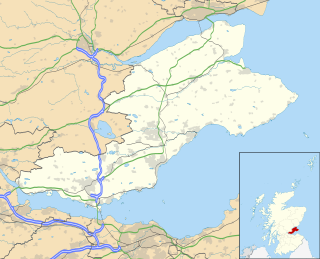
The Barony of Denboig is a Scottish feudal barony Parish in the county of Fife in Scotland. In the medieval period the church and parish of Dunbog originally belonged to the Abbey of Arbroath in Angus. Arbroath or Aberbrothock Abbey was initially a Cluniac Priory founded by King William the Lion in 1178, later, around 1233, it was taken over by Tironsian monks from Kelso Abbey. Arbroath Abbey is famed as the site of the signing of the Declaration of Independence in 1320. Within the parish of Dunbog stood the Cistercian Priory of Cadvan, a cell of nearby Balmerino Abbey. Balmerino Abbey which lies on the shores of the River Tay, across from Dundee, was founded as a Cistercian house by the widow of King William the Lion in 1236. The only building of historical significance in modern Dunbog is Dunbog Mansion house which is built on the site of Cadvan Priory. At one point it was occupied by Cardinal David Beaton [born 1494- died 1546].
Sir William Honyman, 1st Baronet, also known by his judicial title Lord Armadale, was a Scottish landowner, and judge from Orkney. On his lands in Sutherland he was one of the first landlords to evict tenants in order to create sheep farms, a process which grew to become the Highland Clearances.
William Dishington was an Scottish noble.
References
- ↑ "Dishington". House of Names. Retrieved 13 February 2013.
- ↑ Wood, Walter (1887). The East Neuk of Fife: its history and antiquities. Edinburgh: D. Douglas.
- ↑ Hossack, Buckham Hugh (1900). Kirkwall in the Orkneys. W. Peace.
- ↑ University of St. Andrews Institute of Scottish Historical Research